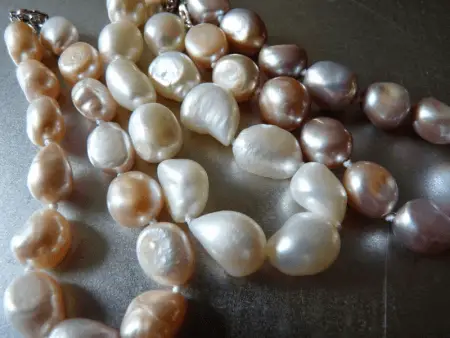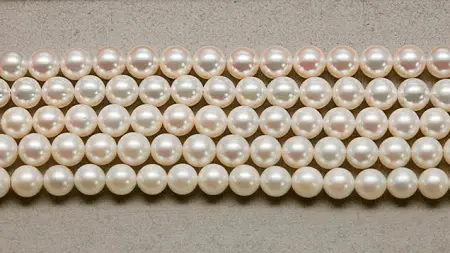Pearls have been consistently popular among jewelry wearers and collectors. Aside from their luster and unmissable beauty, people believe that pearls symbolize purity, loyalty, generosity, wealth and luck.
Natural pearls are rare and high-priced, which is why most pearls sold on the market these days are cultured.
These can be saltwater or freshwater pearls. However, one may ask, what’s the difference between the two?
Summary Table
| Freshwater Pearl | Saltwater Pearl |
| Produced in lakes, ponds, and rivers | Harvested from seas and oceans |
| Has a thick nacre | Has a thin nacre |
| Not very glossy | Very lustrous |
| More affordable | Expensive |
| Durable because of its thick nacre | Vulnerable to chipping due to its thin nacre |
| Comes in different shapes and sizes | Round and mostly cream-colored |
Definitions

Freshwater Pearls are harvested from mussels that dwell at the bottom of ponds, rivers and lakes. These pearls usually have thicker nacre (mother-of-pearl outer coating), so they are not very glossy. Pearls from freshwater are not always round and white. These imperfect pearls, also called “baroque,” however, are just as valuable as the perfectly round ones.
Many years ago people harvested freshwater pearls after only two years of growing them, so they were significantly smaller and of lesser quality.
New methods and techniques have been developed over time, so freshwater pearls nowadays are harvested after 4-6 years, resulting in bigger, higher quality pearls.
Moreover, freshwater pearls are notably affordable. The mussels that produce them are large and can sometimes hold up to 50 pearls each. These pearls are also durable because of their thick nacre.

On the other hand, saltwater pearls grow inside oysters in the seas and oceans. These pearls have thin nacre (about .5mm to 5mm) so they have a distinct shine. Pearls from salt water are usually perfectly round – the most sought-after shape – and cream-colored (Tahiti pearls, however, are uniquely black because of the type of mussels that grow them).
A saltwater pearl’s shape and shine make it a more expensive option than freshwater pearls.
It is also more susceptible to chipping because of its thin nacre.
Freshwater vs Saltwater Pearls
What, then, is the difference between freshwater and saltwater pearls?
Freshwater pearls are from lakes, ponds and rivers while saltwater pearls are from seas or oceans. Pearls from fresh water have a thicker nacre, dull shine, and may come in different shapes and colors. Meanwhile, the ones from salt water are round, lustrous (because of their thin nacre), and mostly cream-colored (except for Tahiti pearls).
When it comes to the cost, a freshwater pearl is significantly more affordable than a saltwater pearl since the mussels that produce freshwater pearls are large and can hold up to 50 pearls each. A saltwater pearl’s distinct shine and perfect shape also contribute to its high price and uniqueness. A freshwater pearl, which has thick nacre, is also more long-lasting than a saltwater pearl.





